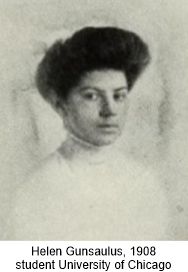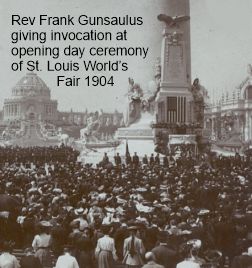|
William's family had moved to Buenos Ayres, Argentina, in 1892
when his father — William McLaughlin (1849–1921), married to Mary
Rebecca Long McLaughlin (1852–1925) — began a thirty-year career
as pastor of a Methodist Episcopal church there.
Nine years later, at age 16, William Jr. was sent to
Delaware, Ohio, to study at Wesleyan University.
In his sophomore year, McLaughlin spent the 1903 Christmas
holiday in Chicago visiting his aunt and uncle, Dr.
Frank W. and Georgeanna Long Gunsaulus. Georgeana
Gunsaulus was sister to William's mother, Mary.
William's cousin Martha Gunsaulus's wedding to Henry
Hamilton Schueler was to be part of the holiday
festivities, and William was to be an usher. The
wedding was to be held at the Gunsaulus home at 2618
Prairie Avenue on either December 31, 1903, or
January 2, 1904 (conflicting reports about the
date). Some newspapers reported that the wedding was
canceled, others that guests were wired not to
attend, and a small ceremony of immediate family
members was held.
Another Gunsaulus was at the Iroquois
According to a report from a
Mrs. Charlotte Powers Ullman, Frank and Georgeanna's
youngest daughter was also in the auditorium at the
Iroquois. In a letter to her sister in London
postmarked January 20, 1904, Charlotte wrote:
"That poor nephew of Mrs. Gunsaulus! He was horribly
burned. He was the son of a Methodist minister and
been in a theater only once before in his life as
his father was very much opposed to such amusements.
As he was walking by he thought he would go in to
see where his uncle Frank was preaching for the
first time next Sunday. Added to the poor boy's
physical anguish was mental suffering, and although
Dr. Gunsaulus said all he could to relieve his mind
it was in vain.
"Dr. Gunsaulus' youngest daughter
was in the theater seated near the front with her
escort. When the crowd began to go by them he held
her, and would not let her move until the greater
number had passed them. Then putting her before him,
and grasping her under the arms like a vice, not
allowing her to look back lest she should become
panic stricken, for the curtain was burning behind
them, he succeeded in getting her out." †
Helen was the youngest Gunsaulus
daughter and would have been seventeen years old in
1903. My efforts to verify her presence at the
Iroquois Theater
failed. Her three older sisters were Martha,
due to marry the day after the fire, Mary,
and Beatrice. The Ullman and Gunsaulus
families traveled in the same circles but I found no
evidence of direct association. The portion of
Charlotte's letter related to William McLaughlin
entering the theater and his deathbed anxiety does
not expand upon the widely published newspaper
story, but the part about a Gunsaulus daughter
escaping from the Iroquois was not published and may
have come from Charlotte's son Henry Ullmann.
Only a few years older than Helen and her sisters,
Henry had joined the search party for the
Long girls so was perhaps privy to stories that
escaped newspaper notice.
Frank Gunsaulus' prominent role in the Armor
Institute made the Gunsaulus part of Chicago
society, with newspapers eager to report on their
travels, parties, recitals, weddings, and
engagements. Assuming Charlotte's account is
accurate, news of a Gunsaulus escaping from the
Iroquois, in conjunction with the story of nephew
McLaughlin's heroics, would have seriously hiked
interest in an already hot story. The omission
cannot have been accidental. Newspapers either
repressed the story of Helen Gunsaulus' escape or
the family concealed it from the press. The
question is why. Perhaps Helen's escort was another
Methodist family member in town for her sister's
wedding who did not want to incur condemnation for
being in a theater.

|
 |
William was taken to the Presbyterian Hospital where he
died the evening after the fire. Reportedly, someone
offered to remove his Delta Tau Delta fraternity pin
for safekeeping, but he said it was not necessary.
Period reports varied as to his exact words about
the pin.
William had one sister, Mary Keen
McLaughlin, who married Henry R. Storer. William was
buried in the Gunsaulus family plot in Forest Home
Cemetery near Chicago.‡
In the years after the fire
Martha and Henry married and had five children.

Helen
Cowen Gunsulus (1886–1954) became a
noteworthy scholar, author and curator,
specializing in Japanese costumes and artwork as
found in her father's collection of Japanese prints
and swords. She did not marry but had a long
term relationship with another curator, Helen Mackenzie.
|
Story of how William McLaughlin came to be in the
theater is improbable
In the published account, William was passing
by the Iroquois when the fire started, a
happenstance pedestrian who paused to inspect the architecture
of a building where his uncle was to
preach the following Sunday. Upon learning
there was a fire inside he sprang into action,
entered the theater and made it to the
third-floor fire
escape to help women and children escape
by crossing Couch Place on planks.
For that to have happened, William
would have had to enter the theater
through locked doors at the front
entrance, climb multiple flights of
stairs, and cross the third-floor gallery
to the fire exit — in the process pushing
through over a thousand terrified people
frantically trying to move in the
opposite direction. He would have had to
climb over an eight-foot block of
entangled bodies of dying victims on the
landing, break through an interior
blocked door, push through a thick throng
of people at a gallery doorway, then
through the mass of three hundred people
in the gallery. In smoke-filled
darkness, in a building with complex
stairways and hallways, with which he
had no familiarity. Most telling, I
think, is that even had he been able to
conquer all those obstacles, why would
someone bent on saving lives pass by and
climb over hundreds of trapped and
dying people to get to a different group
of trapped and dying people? It is
far more likely that William was in the
balcony when the fire started. He
might even have been the escort who got
Helen Gunsaulus (left)
out of the theater but I think not.
That would have required his then making
it back into the theater and up to the
third floor fire escape, a near impossibility.
Today Methodist colleges offer degrees
in performance arts, but in 1903,
Methodist churches were outspoken in
their condemnation of the theater, even
passing an "amusement ban" to clarify
and assert their position. That theater attendance was
taboo for William, son of a Methodist
minister, is somewhat corroborated by Charlotte Ullmann's
letter (left). I suspect that if
editors of the city's major dailies were
presented with a small fib by a highly
regarded minister of who sought only to
spare William's parents the burden of
shame on top of grief at the loss of
their son, the editors would would have
played along.
That said, there is little doubt that
William McLaughlin did in fact perform
heroically on the fire escape to help people climb
onto the plank. His actions were
observed and reported by one of the
contractors on the other end of the
plank:
Charles Henry Cubbon.
Charles would later send William's parents an engraved two-foot
section of the plank as a tribute to
their son's bravery. After helping
others to cross the plank, William was
one of around fifty people who crossed
the plank himself, and one of about
thirty of those who did not survive. He was
not the only one who helped with the
plank. Four women also stabilized
the plank, of which three survived and
one did not.
|
|
|
Discrepancies and addendum
** Interestingly, decades earlier, William's uncle,
Dr. Frank Gunsaulus, had publicly defended the
theater. Gunsaulus was the first president of the
Armour Institute, today's Illinois Institute of
Technology (IIT), as well as a prominent
Congregational minister, author, Chautauqua
lecturer, philanthropist, and educator. The pastor's
open-mindedness regarding theaters persisted in
1903: two days before the fire he announced that his
Central Church services, for two years held in the
Studebaker Theater, would be conducted at the
Iroquois Theater beginning the following Sunday,
January 3, 1904.
†
Contact me if you would like jpg images of Charlotte
Ullman's letter.
‡ The Indianapolis Journal newspaper
once again reported utterly false information.
It asserted that McLaughlin's body had been shipped
to Indianapolis and would be buried there in the
Crown Hill Cemetery.
William was buried in Chicago in the Gunsaulus
family plot.
|
